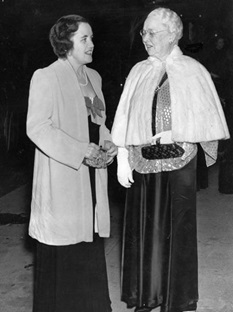Biographical Database of NAWSA Suffragists, 1890 - 1920
Biography of Minerva Kline Brooks, 1883 - 1929
By Elisha Smith, Undergraduate student, Michigan State University
Advisor, Dr. Kristine Byron, Professor
Born to Virgil P. Kline and Minerva E. Cozens Kline, Minerva Kline Brooks was born in Cleveland, Ohio in 1883. She attended Hathaway Brown School in 1899 and graduated from Vassar College in 1903. In 1907, Minerva married Charles S. Brooks in Cleveland. It was after this that her fight for women's suffrage began in Cleveland, and although she left Cleveland later in life, the majority of her work and time was spent on women's suffrage in Cleveland.
Though there is only evidence that Minerva Kline Brooks was actively participating in women's suffrage for a few years, she was very invested in her work and dedicated herself to the women's suffrage cause. In 1910, Minerva Brooks became a charter member in the National College Equal Suffrage League. This group was aimed towards young female college students and recent graduates to help them become politically active for women's suffrage. Minerva Brooks was active in the Cleveland chapter, and also in the Cleveland Suffrage Association. She was also a leader in the Cleveland Suffrage Party (1914), and was a published author in many local newspapers writing about women's suffrage. In 1914, Minerva Brooks was a part of the effort to attain women's municipal suffrage in East Cleveland.
Minerva Brooks moved away from some of her suffrage work around 1915, when she and Charles began working to create an Art Theatre. Together with the help and direction of Raymond O'Neil, they designed the Cleveland Play House and embraced the motto, "Art in Democracy." Minerva Brooks was elected the secretary of the organization, and even performed in the first production, which was a puppet show.
At the end of 1916 Charles and Minerva Brooks moved to New York City to expand their careers. Minerva Brooks wanted to explore interpretive dance, and was even called "an exponent of interpretive dance" by the New York Times. She spent time teaching dance at the Noyes School of Rhythm, before moving back home to Cleveland. In 1925 Minerva and Charles Brooks were divorced. Just a few years later, in 1929, Minerva passed away in Boston. She was survived only by her sister, Mary Kline Pope.
Pictured on the left is Minerva Kline Brooks talking with her friend Francis E. Drury on the right, both founders of The Cleveland Play House.

Sources:
Brooks, Charles Stephen. (2019). Encyclopedia of Cleveland History: Case Western Reserve University. Retrieved from https://case.edu/ech/articles/b/brooks-charles-stephen
Brooks, Minerva Kline. (2019). Encyclopedia of Cleveland History: Case Western Reserve University. Retrieved from https://case.edu/ech/articles/b/brooks-minerva-kline
History. (2019) Cleveland Play House. Retrieved from https://www.clevelandplayhouse.com/about/history
Kneal, Walker. (1938). Founding Ladies of the Cleveland Play House. Retrieved from http://hume.ulib.csuohio.edu/cdm/singleitem/collection/press/id/5183/rec/1
Minerva Kline Brooks. (n.d.). People Pill. Retrieved from https://peoplepill.com/people/minerva-kline-brooks/
Nidiffer J. (2008) The National College Equal Suffrage League. In: The Educational Work of Women's Organizations, 1890-1960. Palgrave Macmillan, New York
The Book of Clevelanders. (1914). The Burrows Bros. Company. Retrieved from https://books.google.com/books?id=sisVAAAAYAAJ&pg=PA39&lpg=PA39&dq=Minerva+Kline+Brooks&source=bl&ots=CittFbVrxC&sig=ACfU3U2soHywXtpHusta6-7sHIP794ZymQ&hl=en&sa=X&ved=2ahUKEwiQjO2x3pzkAhWIY98KHdYJBigQ6AEwB3oECAkQAQ#v=onepage&q&f=false
Wikipedia sketch of Minerva Kline Brooks, accessed online at https://en.wikipedia.org/wiki/Minerva_Kline_Brooks.
